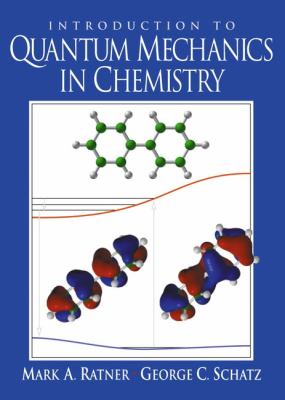198803
9780138954918
Introduction to Quantum Mechanics in Chemistry
by Ratner, Mark A., Schatz, George C.
About this item
- Condition: Very Good
- Provider: gotextbooks sales Contact
- Provider Rating: 63%
- Ships From: Little Rock, AR
- Shipping: Standard

About this item
- Condition: Good
- Provider: GoTextbooks Contact
- Provider Rating: 78%
- Ships From: Little Rock, AR
- Shipping: Standard

Product details
- ISBN-13: 9780138954918
- ISBN: 0138954917
- Publication Date: 2000
- Publisher: Prentice Hall
AUTHOR
SUMMARY
Preface Quantum mechanics, particularly quantum chemistry, is a crucial part of the language of modern chemical science. Terms such asp-d interaction, symmetry-forbidden reactions, bond-order/bond-energy relationships, hypervalency,andexchange repulsionare typical of those that arise in contemporary discussions of chemical structure and properties. This language is a powerful one with which the contemporary chemical scientist needs to be familiar. The language starts with quantum mechanics, and that brings with it some formal and mathematical impediments. Most chemists do not intend to be theorists or even traditional physical chemists. For them, many of the niceties and formal elegances of quantum mechanics are really irrelevant, since their aim is a more utilitarian one: to use quantum chemistry to understand the molecular problems or the materials problems that arise in their own research and understanding. Within the past 15 years, the broad applicability and availability of appropriate modeling tools has made quantum chemical techniques part of the arsenal of most chemists. Indeed, more electronic structure calculations are published by people who do not call themselves physical chemists than by people who do! Given this situation, we felt that it was appropriate to write a text focused on the language of quantum chemistry and the tools that it makes available. The approach is straightforward: It attempts to avoid all unnecessary complexity, detail, and formalism. The book is not written for theorists; rather, it is intended to allow all chemical scientists to become familiar with the language of quantum chemistry and with the use of many of its most important tools. The book is designed to provide an integrated approach to the conceptual development of quantum chemistry and to its application in current research questions. It is intended to be modest and straightforward, easily completed in its entirety either in a one-semester formal course (at the advanced undergraduate or beginning graduate level) or as a self-study document that can be completed in about 50 hours of reading, problem solving, and computer exercises. The in-chapter exercises are intended to demonstrate problem-solving methods. We recommend trying to solve them before looking at the solution that is given. (Answers, to odd-numbered exercises are provided in the appendix to this text. Full solutions are available to instructors by contacting Prentice Hall and requesting ISBN 0-13-015487-3.) The problems at the end of each chapter are of differing levels of difficulty; some (for example, Problems 2.12, 6.5, 8.8, 8.11,13.4, 14.11, and 15.6) contain important thematic material. The computer exercises (especially those in Chapter 14) are an important part of the book, just as, to most chemists, computational applications are arguably the most important contribution of quantum chemistry. The methods discussed in Chapters 11,12, and 14 are available through the use of a large number of commercial and freeware codes. Such software permits the chemist to answer, more accurately and efficiently, many of the questions involving molecular structure and response that arise in understanding the behavior of molecules. The book is intended for chemists, materials scientists, and chemical engineers who wish to learn the language of quantum chemistry and the computational methods that it provides. The volume can also serve as a bare-bones introduction for those who intend to pursue quantum chemistry more deeply, perhaps supplemented by some of the texts that are discussed in the bibliographies at the end of each chapter. Our more advanced book,Quantum Mechanics in Chemistry(Englewood Cliffs, NJ-Prentice Hall, 1993), is organized so that one can jump directly from Chapter 14 of the present book to Chapter 3 of that one, so as to provide enough material for an entire year's courseRatner, Mark A. is the author of 'Introduction to Quantum Mechanics in Chemistry', published 2000 under ISBN 9780138954918 and ISBN 0138954917.
[read more]


